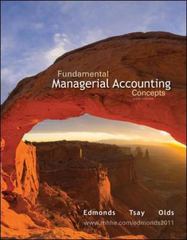Question
John, single, operates a calendar-year sole proprietorship. In 2019, John sold the following assets: 1.Shares of Apple stock - purchased for $40,000 in 2016; sold
John, single, operates a calendar-year sole proprietorship. In 2019, John sold the following assets:
1.Shares of Apple stock - purchased for $40,000 in 2016; sold for $96,000 in 2019
2.Shares of Amazon stock - purchased for $30,000 in 2019; sold for $45,000 in 2019
3.Shares of Snap stock - purchased for $90,000 in 2016; sold for $60,000 in 2019
4.Shares of Starbucks stock - purchased for $20,000 in 2019; sold for $4,000 in 2019
5.Seattle office building used in John's business (building only; does NOT include land)
purchased for $240,000 and placed in service on January 1, 2016
depreciated under MACRS GDS
sold for $240,000 on January 10, 2019
section 179 and bonus depreciation do not apply
6.Personal property used in John's business
100% business-use
5-year MARCS recovery period
purchased for $100,000 and placed into service on October 1, 2017; no other personal property was purchased or placed in service in 2017
depreciated under MACRS GDS
elected out of bonus depreciation and no section 179 election
sold for $50,000 on September 1, 2019
A.Assuming that these 6 assets are the only property that John disposed of in 2019, what will be the amount and character of his gains and/or losses in 2019 after any applicable netting?
Note: John has no nonrecaptured net 1231 losses from the prior 5 years
B.John earned over $700,000 in wages in 2019, and he is in the 37% marginal tax bracket in 2018. After the netting process, what is the tax treatment of John's gains and losses (e.g. what tax rate(s) will apply to gains and what amount of the losses are deductible)?
What additional tax(es) is John potentially liable for?
C.How would your answer to Parts A and B change if John sold the business-use personal property (item 6 on the list) for $5,000 instead of $50,000?
Assume that after selling all 6 assets (selling the Apple stock, Amazon stock, Snap stock, the Starbucks stock, the Seattle office building and selling the business-use personal property for the original $50,000 (not the $5,000 sale price assumed in Part C)), John came to you late in 2019 for a tax planning consultation. John is currently in the 37% marginal tax bracket, but John has decided to retire at the end of 2019, and he expects that he will drop to a much lower marginal tax bracket (10%) beginning in 2020 (and continuing indefinitely). John owns two additional assets that he wants to completely dispose of within the next 12 months. The assets are (i) Nike stock purchased for $70,000 in early 2019 that is currently worth $50,000 and (ii) Adidas stock purchased for $75,000 in early 2019 that is currently worth $100,000.
D.What advice would you give to John regarding when to sell the Nike and Adidas stock and why? What tax planning strategy(ies) does this advice utilize?
John only sold the Seattle office building because he moved his business to Boston in early 2019 (before he decided to retire at the end of 2019) and needed the funds to purchase a new office building in Boston. Instead of selling the Seattle office building and buying the Boston office building, assume that John engaged in a like-kind exchange. John gave the Seattle office building (worth $250,000), and, in exchange, he received the Boston office building worth $245,000 plus $5,000 cash.
E.What are John's tax consequences as a result of the exchange? What is John's basis in the Boston office building?
Step by Step Solution
There are 3 Steps involved in it
Step: 1

Get Instant Access to Expert-Tailored Solutions
See step-by-step solutions with expert insights and AI powered tools for academic success
Step: 2

Step: 3

Ace Your Homework with AI
Get the answers you need in no time with our AI-driven, step-by-step assistance
Get Started


